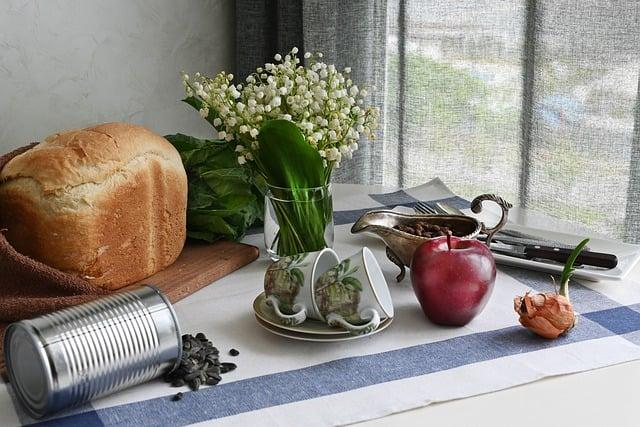Once upon a time in a cozy English kitchen, the air was thick with the scent of spices and sweet fruits. It was Christmas Eve, and a family gathered around the table, each member taking turns to stir the rich, dark mixture of suet, currants, and treacle. Legend had it that the pudding, known as “plum pudding,” brought good fortune to those who helped make it. As the clock struck midnight, the pudding was steamed to perfection, adorned with a sprig of holly. When served, it was ignited with brandy, casting a warm glow that symbolized the joy and togetherness of the season.
Table of Contents
- The Rich History Behind British Christmas Pudding
- Ingredients That Make the Perfect Pudding
- Traditional Preparation Methods and Modern Twists
- Serving Suggestions to Elevate Your Christmas Feast
- Q&A

The Rich History Behind British Christmas Pudding
Christmas pudding, a staple of festive feasts, boasts a rich tapestry of history that intertwines with British culture. Its origins can be traced back to the medieval period, where it was initially a savory dish known as “pottage,” made with meat and vegetables. Over the centuries, this dish evolved, gradually incorporating dried fruits, spices, and sweeteners, reflecting the changing tastes and agricultural practices of the time. By the 16th century, the pudding began to take on its modern form, becoming a symbol of celebration and abundance during the Christmas season.
The tradition of making Christmas pudding is steeped in ritual and symbolism. Families often gather to prepare the pudding together, each member stirring the mixture while making a wish, a practice believed to bring good fortune for the coming year. **Key ingredients** such as suet, flour, and a variety of dried fruits are combined with spices like cinnamon and nutmeg, creating a rich and dense dessert. The pudding is then steamed for hours, allowing the flavors to meld beautifully. As it is served, it is often flambéed with brandy, creating a dramatic presentation that adds to the festive atmosphere. This beloved dessert not only delights the palate but also serves as a reminder of the enduring traditions that have shaped British Christmas celebrations through the ages.

Ingredients That Make the Perfect Pudding
To create a truly memorable pudding, a harmonious blend of ingredients is essential. **Dried fruits** such as raisins, currants, and sultanas are the backbone, providing natural sweetness and a chewy texture. **Spices** like cinnamon, nutmeg, and allspice add warmth and depth, evoking the festive spirit of Christmas. The inclusion of **zest from citrus fruits**—particularly oranges and lemons—brightens the flavor profile, while **dark brown sugar** contributes a rich, caramel-like sweetness that complements the fruits and spices beautifully.
Another key element is the **fat**, traditionally suet, which lends a moist richness to the pudding. For a vegetarian alternative, shredded vegetable suet or butter can be used. **Breadcrumbs** help to bind the mixture, giving it structure, while **eggs** provide essential moisture and act as a leavening agent. a splash of **alcohol**, such as brandy or stout, not only enhances the flavor but also aids in the preservation of the pudding, allowing it to be made well in advance of the festive season. Each ingredient plays a vital role, coming together to create a dessert that is both indulgent and steeped in tradition.

Traditional Preparation Methods and Modern Twists
Christmas pudding, a beloved staple of British festive celebrations, has its roots in medieval England, where it was originally a savory dish made with meat and spices. Over the centuries, this dish evolved into the sweet, rich dessert we know today, typically made with a blend of dried fruits, suet, and spices. Traditional preparation methods involve a meticulous process of mixing the ingredients, often with family members taking turns stirring the mixture while making a wish. The pudding is then steamed for several hours, allowing the flavors to meld beautifully, and is traditionally served with a sprig of holly on top, symbolizing the festive spirit.
In recent years, innovative chefs have embraced the classic recipe, infusing it with modern twists that cater to contemporary palates. Some popular adaptations include:
- Vegan versions: Substituting suet with plant-based fats and using alternative sweeteners.
- Flavored variations: Incorporating unique ingredients like chocolate, ginger, or even whiskey for a bold flavor profile.
- Presentation changes: Serving in individual portions or as a deconstructed dessert, allowing for a fresh take on this traditional favorite.
These modern interpretations not only honor the rich history of Christmas pudding but also invite a new generation to enjoy this festive treat in exciting and diverse ways.

Serving Suggestions to Elevate Your Christmas Feast
To truly elevate your Christmas feast, consider serving your traditional British Christmas pudding with a selection of delightful accompaniments that enhance its rich flavors. **Brandy butter** is a classic choice, offering a creamy, sweet contrast that melts beautifully over the warm pudding. For a touch of elegance, **fresh cream** or **custard** can be poured generously, adding a luscious texture that complements the dense, fruity pudding. You might also want to include **vanilla ice cream** for a refreshing twist, creating a delightful temperature contrast that will surprise your guests.
Presentation is key when serving this festive dessert. Consider garnishing each serving with **toasted almonds** or **candied fruits** for a pop of color and added crunch. A sprinkle of **powdered sugar** can create a snowy effect, enhancing the festive atmosphere of your table. For those who enjoy a bit of theatrics, set the pudding alight with a splash of brandy just before serving, creating a stunning visual that will leave your guests in awe. With these thoughtful touches, your Christmas pudding will not only taste divine but also become the centerpiece of your holiday celebration.
Q&A
-
What is Christmas pudding?
Christmas pudding, also known as plum pudding, is a traditional British dessert served during the festive season. It is a rich, steamed pudding made with a mixture of dried fruits, spices, and often a splash of alcohol, typically brandy or stout.
-
What ingredients are in Christmas pudding?
The key ingredients include:
- Dried fruits (such as raisins, currants, and sultanas)
- Suet or butter
- Flour and breadcrumbs
- Spices (like cinnamon and nutmeg)
- Brown sugar
- Alcohol (usually brandy or beer)
-
How is Christmas pudding prepared?
Christmas pudding is typically prepared by mixing all the ingredients together, then placing the mixture in a pudding basin. It is steamed for several hours, allowing the flavors to meld and develop. Traditionally, it is made weeks in advance to enhance its taste.
-
How is Christmas pudding served?
Christmas pudding is traditionally served on Christmas Day, often flambéed with brandy before serving. It is usually accompanied by a rich sauce, such as brandy butter, cream, or custard, and sometimes garnished with holly for a festive touch.
the British Christmas pudding is more than just a festive dessert; it’s a rich tapestry of history, tradition, and flavor. As you savor each bite, remember the stories and celebrations that have made this pudding a beloved holiday staple.




